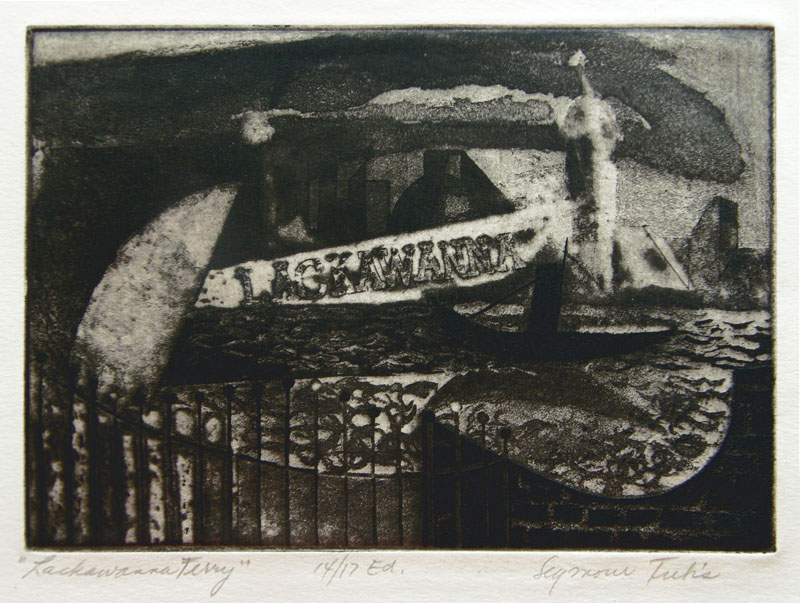Lackawanna Ferry is an aquatint created in 1947 by American artist Seymour Tubis. It is pencil signed, titled, and dated Nov. 1947. Lackawanna Ferry was printed by the artist on ivory wove paper and is editioned 14/17. The reference is Tubis 92 and the platemark measures 5-7/8 x 7 inches.
The Hokoken Terminal was originally named the Lackawanna Terminal due to its connection to the Erie-Lackawanna railroad. It was both a railroad and a ferry terminal and it was where the Delaware, Lackawanna & Western Railroad Company lines ended near the Hudson River and discharged passengers to ferries ran by the New York and Hoboken Ferry Company. The use of the terminal waned after the Holland and Lincoln Tunnels were completed which allowed cars and buses to drive between New Jersey and New York. The terminal interior is Beaux-Arts, designed by Kenneth Murchinson in 1907. Between 1997 and 1999, Hoboken terminal underwent a thorough renovation and, in 2011, the ferries returned.
Seymour A. Tubis, painter, sculptor, printmaker, and educator, was born to Sarah and William Tubis in Philadelphia on September 20, 1919. He was raised principally by his mother after the death of his father in 1927. The family lived in Camden, New Jersey where Tubis attended Woodrow Wilson High School. He studied at Temple University, the Philadelphia Museum School of Art from 1941 to 1942, and the Art Students League in New York with Vaclav Vytlacil, Will Barnet, Harry Sternberg, and Morris Kantor.
Tubis served in the military during World War II beginning in 1942. His job was that of a cartographer in the South Pacific and was he commissioned to paint a mural for the US Army Signal Corps School at Camp Crowder, Missouri. While still in the military, he married Miriam B. Benson in 1944 and he was discharged in 1946. On 7 September 1949, he and Miriam sailed to Europe where he continued his art studies at the L'Académie de la Grande Chaumière in Paris from 1949 to 1950, and the Istituto d'Arte Porta Romana, Florence in 1950.
After Tubis returned to New York, he taught painting and printmaking at the Art Students’ League, the Brooklyn Museum School of Art, and he was an instructor in Adult Education in New York City. He also worked as artist-consultant for the New York Times between 1955 and 1960. In 1962, Tubis moved to New Mexico where he spearheaded the printmaking department of the Institute of American Indian Arts in Santa Fe. He served as chair of the art department from 1963 to 1980.
Tubis was a member of the Society of American Graphic Artists, the College Art Association of America, the Santa Fe Designer Craftsmen, and a life member of the Art Students’ League. His work was included in group exhibitions at the Carnegie Institute, Pittsburgh in 1948; the National Exhibition of Prints, Drawings and Watercolors at the Metropolitan Museum of Art, New York, 1952; Exhibition of American Prints, Royal Society, London, 1954; and the International Exhibition of Graphics at the Seattle Art Museum in 1968. A retrospective of his painting and sculpture was mounted at the Museum of New Mexico (now the New Mexico Museum of Art) in 1964.
Seymour Tubis is represented in the collections of the New Mexico Museum of Art, Santa Fe; the Library of Congress, the National Gallery of Art, and the Smithsonian American Art Museum, Washington, D.C.; and the Worcester Art Museum, Massachusetts.
Seymour Tubis died in Denver, Colorado on May 15, 1993.



